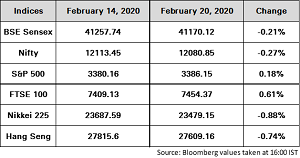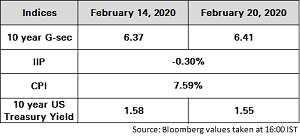Indian Economic Update
- Trade deficit for January widened sharply on a narrowing of import contraction, as some industrial imports saw a minor sequential uptick. Nonetheless, total trade deficit for Apr-Jan FY2020 stands at USD 133 billion, far lower than USD 163 billion seen in 10M FY2019.
- Exports contracted by 1.7% YoY in Jan 2020, with items like gems and jewellery (-12%), leather and products (-8%), readymade garments (-5%), etc. showing declines.
- Import contraction narrowed very sharply in January, by 0.8% YoY, printing at an eight-month high and beating a high base effect.
- Government of India announced the conversion of its securities through auction (switch operation) for an aggregate amount of INR 37,000 crore on Feb 24, 2020.
- Moody’s Investors Service on Monday slashed its 2020 growth projection for India from 6.6% earlier to 5.4%, amid growing concerns over the economic fallout of the novel coronavirus outbreak. Moody’s also reduced its global growth projection, saying that the coronavirus outbreak has diminished optimism about prospects of an incipient stabilisation of global growth this year.
Global Update
- The Federal Open Market Committee (FOMC) minutes indicated that most members saw risks to economic activity as somewhat more favourable than at the previous meeting. However, a number of downside risks were identified as being prominent. FOMC officials also indicated the potential for disruptions from the coronavirus “warranted close watching”. The assessment on inflation remained relatively unchanged.
- China cut the benchmark lending rate on Thursday, as the authorities move to lower financing costs for businesses and support an economy hit by a fast-spreading coronavirus epidemic. The one-year loan prime rate was lowered by 10 basis points to 4.05% from 4.15% at the previous monthly fixing. The five-year Loan Prime Rate (LPR) was lowered by 5 basis points to 4.75% from 4.80%.
- Singapore will post its biggest budget deficit in FY2021 since at least 1997, pledging Singapore Dollar (SGD) 6.4 billion (USD 4.6 billion) in dedicated support for an economy being slammed by the coronavirus outbreak. The deficit will widen to 2.1% of Gross Domestic Product (GDP) in the year through Mar 2021 from a projected 0.3% in the current fiscal year, Finance Minister said in Parliament yesterday.

Indian equity markets remained stable. Sentiments improved after Finance Minister said the Government would announce measures to tackle the financial fallout from the coronavirus outbreak amid a fall in new cases in China.
During the week Sensex lost 0.21% to close at 41170.12 while Nifty declined 0.27% to close at 12080.85.

Indian Government bonds ended steady as mood remained buoyant after steps taken by the RBI on surplus liquidity.
The 10Y benchmark yield ended at 6.41% as compared to the previous week’s close of 6.37%.
Oil traded higher after a slowing of new coronavirus cases in China eased demand worries and supply was curtailed by a U.S. move to cut more Venezuelan crude from the market. U.S. shale production is expected to rise to a record 9.2 million barrels per day next month, according to the Energy Information Administration.
Gold traded higher, as worries over the economic damage by the coronavirus outbreak boosted the appeal for the safe haven asset. However, fall in number of cases might dent the appeal for gold.

The Indian Rupee ended lower against the Dollar tracking Chinese Yuan as risk appetite weakened on deepening fears over coronavirus.
Dollar index traded higher. The risk off sentiment continued to plague markets which was seen supporting the safe haven currencies. The Dollar index, given the relative out performance of the US economy compared to its other peers, surged to fresh highs since October last year.
The Yen also appreciated against the Dollar, however, it traded in a narrow range. The Euro slid further after poor economic data.
Source: ICICI Bank Research, Private Banking Investment Strategy Team, Bloomberg and CRISIL.
Related Content


09.03.2020

28.02.2020









